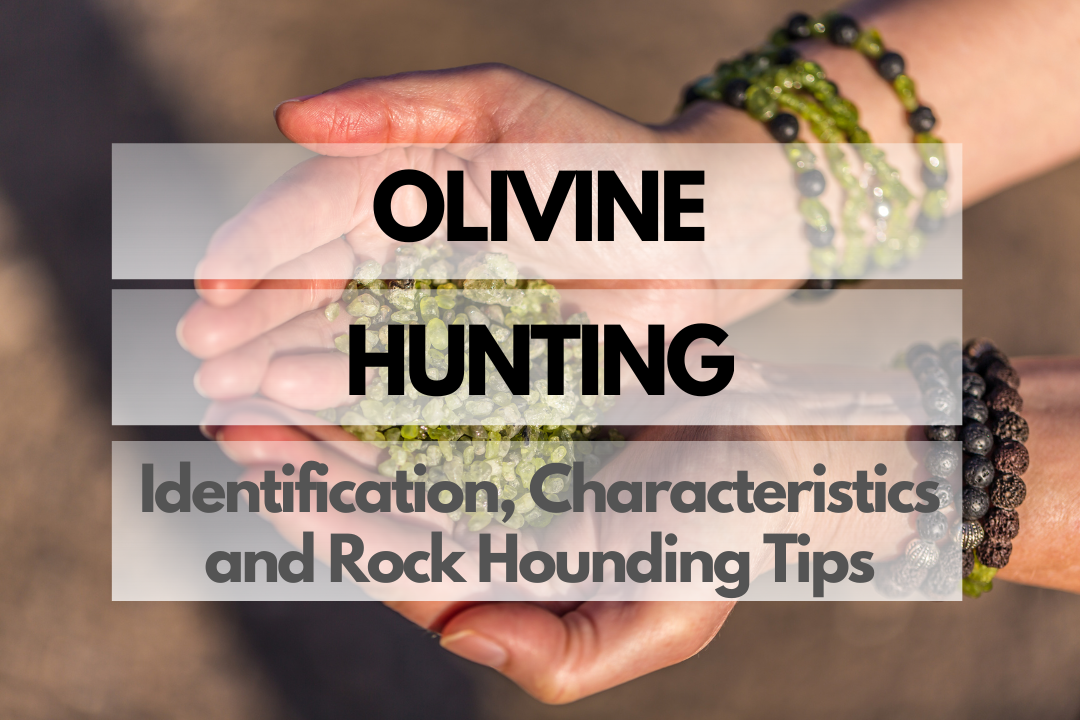Get ready to embark on an exciting journey into the world of olivine hunting! This intriguing rock, known for its stunning green hue, has captivated rock collectors and enthusiasts alike. In this article, we’ll explore the history, identification, characteristics, and rock hounding tips for olivine, so you can start your own collection of these beautiful gems.
History & Origin of Olivine
Olivine is an ancient rock-forming mineral that has been present on Earth since its formation. Its name is derived from the Latin word ‘oliva,’ meaning olive, due to its characteristic green color. This mineral has been used for various purposes throughout history, including as a gemstone, a construction material, and even as an offering to gods in ancient cultures. In Hawaiian culture, olivine is known as the tears of the goddess Pele, as it is commonly found near volcanic eruptions on the islands.
Olivine Identification & Physical Properties
To aid in olivine identification and appreciation of its unique properties, refer to the table below for an overview of its physical characteristics:
| Property | Characteristic |
|---|---|
| Color | Yellow-green to green |
| Luster | Vitreous to resinous |
| Hardness | 6.5-7 on the Mohs scale |
| Transparency | Transparent to translucent |
| Crystal System | Orthorhombic |
| Cleavage | None |
Olivine Colors
Olivine typically exhibits a range of green hues, from pale yellow-green to deep olive green. The variation in color is determined by the amount of iron and magnesium present in the mineral’s crystal structure. Higher concentrations of iron result in a darker, more olive-toned green, while higher magnesium concentrations yield a lighter, yellow-green hue.
Olivine Hardness
Olivine has a hardness of 6.5-7 on the Mohs scale, which indicates that it is relatively hard and resistant to scratching. This hardness makes it suitable for use in jewelry and other applications where durability is important.
Olivine Types
Forsterite
Forsterite is the magnesium-rich end member of the olivine series, with a magnesium to iron ratio greater than 9:1. This variety exhibits a lighter, yellow-green color and is considered the more valuable of the two primary olivine types.
Fayalite
Fayalite is the iron-rich end member of the olivine series, with a magnesium to iron ratio less than 1:9. This variety is darker, with a more olive-toned green color. Due to its higher iron content, fayalite is less commonly used in jewelry and other applications.
Olivine Uses
- Jewelry: Olivine, also known as peridot when used as a gemstone, is often cut into faceted stones or beads for use in jewelry.
- Abrasives: The hardness of olivine makes it suitable for use as an abrasive material in sandblasting and other industrial applications.
- Construction: Crushed olivine is sometimes used as a construction aggregate or as a component in cement production.
- Scientific research: Olivine is an important mineral for the study of Earth’s mantle, as well as the formation of meteorites and other extraterrestrial rocks.
How Much Is Olivine Worth?
The value of olivine varies depending on factors such as color, clarity, size, and cut. As a general guideline, expect to pay anywhere from $50 to $500 per carat for faceted peridot gemstones. Keep in mind that larger stones with exceptional color and clarity will command higher prices. In contrast, lower-quality specimens or rough olivine samples will be significantly less expensive, often costing only a few dollars per piece.
Olivine Rock Hounding Tips
Ready to dive into the exciting world of olivine hunting? Here are some tips and tricks to help you have a successful and enjoyable rock hounding experience. We’ll cover essential tools and equipment, safety tips, where to find olivine, and how to care for your precious finds.
Essential Tools and Equipment
Before you head out on your olivine hunting adventure, make sure you’re equipped with the right tools to make your trip a success:
- Geology hammer: A necessity for breaking open rocks and extracting samples.
- Chisel: Useful for prying apart rocks and exposing olivine crystals.
- Hand lens or magnifying glass: Helps with identifying and examining your finds.
- Field guide or mineral identification book: Provides valuable information on olivine and other minerals you may come across.
- Sturdy backpack or collecting bag: For carrying your tools and collected specimens.
- GPS or map: To help you navigate and locate prime olivine hunting areas.
Safety Tips
Rock hounding can be a fun and rewarding hobby, but it’s essential to keep safety in mind. Follow these safety tips to ensure a safe and enjoyable experience:
- Always wear proper protective gear, including sturdy shoes, gloves, safety goggles, and a hard hat if necessary.
- Carry a first aid kit and be prepared for any emergencies that may arise.
- Stay hydrated and bring plenty of water, especially when exploring in hot or remote areas.
- Be aware of your surroundings and avoid dangerous situations, such as unstable cliffs or slippery surfaces.
- Make sure someone knows your plans and expected return time, in case of emergencies.
Olivine Hunting: Where to Find Olivine
Olivine can be found in a variety of geological settings, most notably in areas with volcanic activity or in the Earth’s mantle. Some of the best places to find olivine include Hawaii, Arizona, New Mexico, and even the beaches of Norway. The table below provides specific locations where you can hunt for olivine around the world:
| Site/Area | City/State/Country |
|---|---|
| Papakolea Beach (Green Sand Beach) | Big Island, Hawaii, USA |
| Peridot Mesa | San Carlos Apache Reservation, Arizona, USA |
| Kilbourne Hole | Las Cruces, New Mexico, USA |
| Zabargad Island | Red Sea, Egypt |
| Leka Island | Nord-Trøndelag, Norway |
Caring For Your Olivine
Once you’ve collected some beautiful olivine specimens, it’s important to care for them properly. To clean your olivine, use a soft brush and water to gently remove any dirt or debris. Avoid using harsh chemicals or abrasive cleaning methods that may damage the mineral. Store your olivine in a cool, dry place away from direct sunlight to maintain its vibrant color and prevent fading.
Additional Resources
For more information on olivine and rock hounding, consider exploring the following resources:
- United States Geological Survey (USGS): https://www.usgs.gov/
- Mindat.org: https://www.mindat.org/
- Rock & Gem Magazine: https://www.rockngem.com/
- Geology.com: https://geology.com/
- Books: “Rocks, Gems, and Minerals” by Paul R. Shaffer and “The Rockhound’s Handbook” by James R. Mitchell
Here are some frequently asked questions about olivine that you might be curious about:
What are the benefits of Olivine?
Olivine is a beautiful and unique mineral that is highly sought after by collectors and rock enthusiasts. It’s also used in various industrial applications, such as sandblasting, water filtration, and as a refractory material in the production of steel and glass.
Do Olivine have any healing properties?
While some people believe that olivine, particularly the gem-quality variety known as peridot, possesses healing properties, there is no scientific evidence to support these claims. However, many people find the vibrant green color and natural beauty of olivine to be soothing and uplifting.
Do Olivine have any spiritual meaning?
In some cultures and belief systems, olivine is associated with positive energy, growth, and renewal. It’s also considered a stone of compassion and is thought to help with emotional healing and balance. However, these interpretations are subjective and vary from person to person.
Do I need a permit to go Olivine hunting?
In some areas, you may need a permit or permission to collect rocks or minerals, especially on public lands or in protected areas. It’s essential to research the specific regulations for the area you plan to visit and obtain any necessary permits before you go. For more information on permits in the United States, visit the Bureau of Land Management (BLM) website: https://www.blm.gov/
Closing Thoughts
Now that you’re equipped with the knowledge to embark on your olivine rock hounding adventure, it’s time to get out there and start exploring! Remember to prioritize safety, respect the environment, and enjoy the thrill of discovering this beautiful green mineral. Happy hunting!

